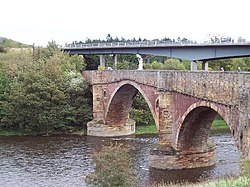Drygrange Old Bridge
| Drygrange Old Bridge | |
| Roxburghshire | |
|---|---|
 Drygrange Old Bridge | |
| Location | |
| Carrying: | Minor lane |
| Crossing: | River Tweed |
| Location | |
| Grid reference: | NT57533468 |
| Location: | 55°36’14"N, 2°40’32"W |
| Structure | |
| Main span: | 105 feet |
| Material: | Stone |
| History | |
| Built 1776-1780 | |
| Architect: | Alexander Stevens |
| Information | |
Drygrange Old Bridge is a disused road bridge over the River Tweed near Melrose in Roxburghshire. It crosses the river at the foot of Lauderdale, a few hundred yards above the point that the River Leader joins the Tweed: the county border with Berwickshire runs down the Leader to the Tweed and then follows the Tweed downstream.
Three bridges cross the Tweed here, each close by the other. Running upstream they are:
- Leaderfoot Bridge
- Drygrange Old Bridge
- Leaderfoot Viaduct
History

Drygrange Bridge was built between 1776 and 1780 to a design by the architect and engineer Alexander Stevens.[1][2] It replaced a ferry as part of an improvement to a turnpike road.[2] It is today a Category A listed building.[1]
The bridge carried the A68 over the Tweed until 1974 when it was replaced by a box girder bridge to the east, engineered by Sir Alexander Gibb & Partners.[1] The old bridge is not open to vehicles, but can be crossed by pedestrians and bicycles.
Design

The Old Bridge has a central span of 105 feet, with two side spans of 55 feet, and a smaller arch in the south abutment.[1][2] The central arch has a rise of 34 feet.[2] The rounded cutwaters are carried up to the level of the roadway and are topped with angular pedestrian refuges.[2]
Hollow spandrels reduce the weight of the structure, an innovation by Thomas Telford.
The bridge has been modified by raising the level of the roadway on the approaches to make it more level, but the level of the original roadway can be seen in the string course on the exterior of the bridge.
The bridge is near to the Roman settlement of Trimontium, which is to the south-west of the viaduct. To the west of the bridge is the Leaderfoot Viaduct, a disused railway viaduct, and to the east of the Old Bridge is its modern successor. This group of three bridges is sometimes known as 'Tripontium',[3] in tribute to the Roman Trimontium.
Outside links
| ("Wikimedia Commons" has material about Drygrange Old Bridge) |
References
- ↑ 1.0 1.1 1.2 1.3 Drygrange Old Bridge (Category A) - Listing detail (Historic Environment Scotland)
- ↑ 2.0 2.1 2.2 2.3 2.4 RCAHMS record of Drygrange Old Bridge
- ↑ RCAHMS record of Leaderfoot Viaduct
| Bridges and crossings on the River Tweed | ||||||
|---|---|---|---|---|---|---|
| Melrose Bridge | Gattonside Suspension Bridge | Leaderfoot Viaduct | Drygrange Old Bridge | Leaderfoot Bridge | Dryburgh Suspension Bridge | Mertoun Bridge |